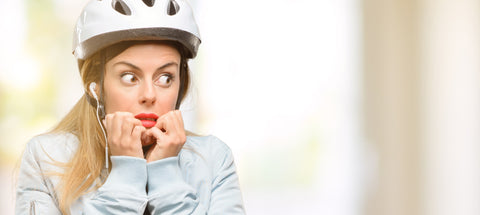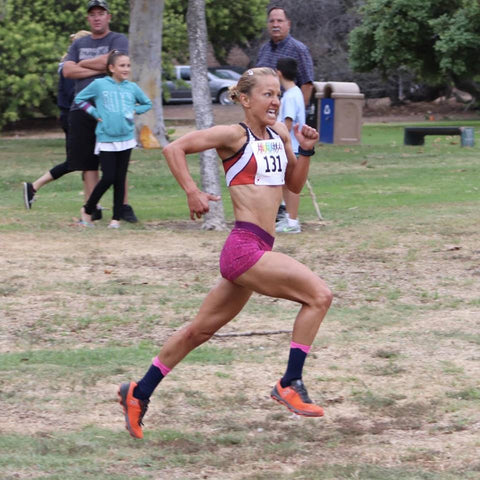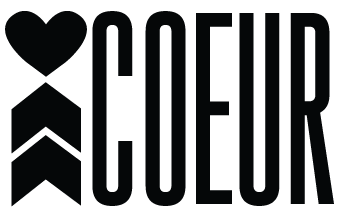Here’s a money-back guarantee: at some point in your life, your brain will try to sh!t the bed in anticipation of a scary event related to sport, work, relationships, or Karaoke. In some cases, your terrified brain may actually win – you bail, fake illness or injury, or you simply come clean – “Nothing is worth feeling like this. I’m done with… [racing, swimming, biking, this job, this town, elevators, singing Careless Whisper in front of work colleagues].”

We’re talking about the biggest a-hole of all, Anxiety. You all know the feelings: the racing heart, the clammy hands, the surge of fear and self-doubt; the nausea, the crappy sleep – all because we desperately want to do a kick-ass job as the best version of ourselves possible, and, in the process, convince Señora Cerebro that we’re not a total loser.
These reactions are perfectly normal - even the self-doubt and getting the poops. I only have to talk to Lesley Paterson about her upcoming race at the XTERRA World Championships and within minutes the response comes… “I need the toilet!” (Shrinks call this ‘anticipatory anxiety,’ Lesley calls it “STFU, Simon”).

Even world-class athletes like Lesley Paterson can get anxious
While unpleasant at the time, these reactions serve an important evolutionary function to help us survive – they increase our chances of avoiding danger, winning a fight, or running like a champ when the fan is on full speed and the pooh is heading towards it. In situations that aren’t life threatening, anxiety responses are simply there to convince us to stay home so our ego doesn’t run the risk of being used as a door mat.
There’s anxiety, and then there’s a panic attack. This article isn’t about getting the squits before a race. For almost 2.5 million Americans each year (and growing), anxiety reactions don’t end there. For these people, anxiety visits them with such brutal, unforgiving and terrifying force that we call it a PANIC ATTACK. Panic attacks come with a veritable pooh storm of symptoms that usually appear very rapidly (<10min) and can feel paralyzing, often for 20-30 minutes. High autonomic arousal can cause uncontrollable trembling, hot flashes or chills, a feeling of choking or unable to get your breath, and even a strange sense of detachment from the world or your own body. Psychological symptoms follow the physical symptoms at lightning speed as panic gets interpreted by your brain: you might be convinced that you’re having a heart attack (you’re not), going to faint (you won’t), or that you’re dying (no, no, no). You might feel an overwhelming sense of losing control, a need to escape. Sometimes the fear of humiliation or embarrassment emerges because catastrophic thoughts take root: “people will think something’s wrong with me or that I’m a lunatic,” or “this is so embarrassing.” This becomes the self-perpetuating signature of a panic attack: the body’s fight or flight response is followed by a catastrophic interpretation of symptoms, which increases the fight or flight response further, which leads to more catastrophic thinking, and so on. Down the rabbit hole we go.
And biology keeps kicking us while we’re down: the psychological component of panic causes us to become hypervigilant to the symptoms (“I hope I don’t have another panic attack” or “do I have any symptoms yet?”), akin to rolling out the red carpet for future panic. As we get more anxious, our brain starts to develop a stronger bias toward negativity and pessimism such that even subtle symptoms eventually get noticed and interpreted catastrophically (e.g., “what if I lose a control again?” “What if I have to be saved and dragged out of the water by the kayaker? Urgh, how humiliating!”). Even worse, no amount of impromptu self-talk, deep breathing, or Enya songs appear to keep it at bay.

Even Enya can't help
The difference between normal anxiety and a panic attack is like the difference between a mildly annoying headache and a curled-up-on-the-floor-in-the pitch-dark-migraine. You can’t even begin to imagine what it feels like until you’ve experienced it.
Here’s how “Emily” describes it…
“For me, a panic attack is almost a violent experience. I feel disconnected from reality. I feel like I'm losing control in a very extreme way. My heart pounds really hard, I feel like I can't get my breath, and there's an overwhelming feeling that things are crashing in on me. In between attacks there is this dread and anxiety that it's going to happen again. I'm afraid to go back to places where I've had an attack. Unless I get help, there soon won't be any place where I can go and feel safe from panic."
Or how a mom describes her daughter’s experience during an attack:
“[My daughter] says when it happens it’s like she’s watching it happen from the outside and feels like she can’t respond or reason when we’re talking to her…. …she says [my] suggestions just get all jumbled up but being left alone is the scariest and worst reaction.
When panic attacks become frequent, unexpected, and when worries about having future panic attacks becomes a big concern, they’re often diagnosed as Panic Disorder (PD). PD is also frequently accompanied by agoraphobia -- a perceived inability to escape or get help if a panic attack occurs (e.g., in crowded or confined places such as malls, concerts, tunnels, elevators, being alone, being far from home, etc.). However, panic attacks can occur as part of a generalized anxiety disorder without a diagnosis of PD, which is often the case for triathletes. Thus, if your panic attacks happen under predictable circumstances (e.g., open water swimming), you probably don’t have a panic disorder, unless your first panic attack was also unexpected. Complicated, I know. However, the bottom line is that only a doctor can diagnose PD, and no amount of internet surveys, blog posts, or time with Dr Google can tell you otherwise.
OH, BTW, some panic isn’t technically panic. In some cases, what feels like a panic attack can actually caused by something else – exercise induced asthma, cold water shock reflex, thyroid dysfunction, or an abnormal heart rhythm can all be culprits. It’s just your body’s way of saying WTF? So just because you feel some of the symptoms of panic, it doesn’t mean you’re experiencing a panic attack. Only your doctor can rule out these other conditions first.
Triathletes get panic attacks. Among triathletes, the most common scenarios for panic attacks are swimming in open water, descending on a bike at speed, and riding in busy traffic. These predictable events have become traumatic stressors usually because of a direct experience or witnessing an event involving actual or threatened danger – such as a near drowning or a bad crash. These are encoded in the brain as ‘traumatic memories’ and wreak all sorts of havoc with our fight or flight response. Wouldn’t it be great to just erase a traumatic memory entirely and stop the cascade of misery once and for all? Unfortunately, quirks in our brain biology prevent this happening (or at least make it extremely unlikely). Why? Because when our experiences occur alongside a humungous stress response, the hormones cortisol, epinephrine and norepinephrine tell the hippocampus to cold-forge the memories (or more correctly the sensory experience of the traumatic event) with such vigor that we can’t actually forget them –evolution’s way of making sure we don’t put ourselves in those situations again. There are cases of ‘unremembered trauma’ or suddenly ‘recovered’ memories, but these are mostly limited to specific instances of childhood trauma. The overwhelming conclusion from research is that traumatic memories are here to stay. God damn it.
Panic attacks are not a sign of weakness, poor coping skills, or lack of experience. They can be unprovoked and unpredictable, and that’s partly what’s make them so scary – but for most triathletes they are triggered by stressful events with a definite cause. Panic attacks are twice as common among women as they are men, a risk-gap that gets bigger with age. There are lots of hypotheses about why women are more prone, but scientists don’t actually know for sure. When the panic attacks are unexpected, doctors don’t even know exactly what causes them. We do know that they can be triggered by stressful events, changes in your environment (e.g., new job, new school, new city, new anything), personality/temperament, genetics, existing mental health struggles (e.g., depression, general anxiety), and what’s often referred to as “unclassified stimuli” -- meaning we have no friggin’ idea. Because untreated ‘panic’ tends to generalize – sufferers discover that even previously ‘safe’ experiences are now fair game for the panic monster. Comfort zones get smaller and smaller and we can feel even more trapped.
OK, that’s the bad news.
The good news is that panic attack is one of the most treatable forms of anxiety. The most successful treatments are therapy and drugs, often together. The therapy with the most success is called Cognitive Behavioral Therapy (CBT). CBT is a “talk” therapy that teaches you specific skills to become more aware of patterns in your thinking, how these patterns shape your feelings and emotions, and how you can improve emotions by challenging unhelpful patterns of thinking. CBT is the most common form of talk therapy, and virtually all legit shrinks are trained how to do it.
If you’ve never had CBT, it usually starts with some simple education on WTF is happening when you panic. Therapists then start to use techniques that target your tendency to ‘catastrophize’ (i.e., “everything’s fucked! I’m doomed!” – No, it isn’t, and No, you’re not), and why panic-brain is terrible at estimating actual risk. Then, therapists start to use “exposures” – a polite way of saying that they help you get used to internal sensations and core fears that you find scary, as well as the situations that provoke that fear. Fortunately, the days of “throwing you in at the deep end” are over (and ignore anyone who tells you that this is what you need) but therapists do gradually ratchet up the stakes once you’re able to cope successfully with scenarios lower down the Shit-My-Pants scale™. Of course, they don’t use my amazing SMP scale, they use proper stuff called ‘stimulus hierarchies’ and ‘systematic desensitization’ protocols. Research examining CBT with adults sufferers suggests that therapist-supported treatment over the internet may be as effective as face-to-face therapy – encouraging news for those unable or unwilling to see a live therapist on a regular basis.
And what about kids? CBT is effective for treating anxiety disorders in kids, but research suggests it isn’t any more effective than non-CBT treatments such as medication, bibliotherapy, or a psychological placebo. If CBT is the chosen treatment for your child, research suggests that only about half of kids actually respond to it. Thus, by all means see if CBT can help your child, but don’t expect miracles.
How to help someone who’s having a panic attack. When someone seems to have all the symptoms of a panic attack, first try to help them get to a calmer location – perhaps sitting on floor, holding onto a kayak -- away from the crowd. Try to avoid telling the person that they “just need to calm down” (don’t you think they would if they could?), that “there’s nothing to nervous about” or “you’re overreacting” (you’re minimizing how scary it feels to them). Besides, many sufferers say they can’t be “talked through them” and attempts to do so can even makes things worse.
“I could never be talked through them. It just didn’t work. What helped me was simple breathing techniques. An app like Calm, which has an option to focus on the breath. Just sort of going inside myself and forcing it all out... …I have also used essential oil inhalers to help me slow down and focus on my breathing. Whether or not the oils help, who knows, but they smell nice and give me a focus.” (Angela, 36)
“When I would have them, my mom would try to comfort me or talk me through them which didn’t help at all. I came to discover that what I needed was someone to just sit quietly with me, not say anything, not offer suggestions, just be there. I definitely feel better when not alone.” (Hattie,” 27)
The best advice is simply to stay with them, reassuring them that you’re there, not discounting the power of the experience itself and reminding them that it will pass. Often, they just need you to sit with them in silence, holding their hand like an anchor to the real world:
“…someone to just tell me “it’s all real. you’re ok.” Sometimes when you panic, things can feel distorted and you are like ‘what the f*ck even is life?’… sometimes it grounds you to have someone say reality is there waiting for ya.” (Megan, 40)
If you do want to offer words of advice, talk in short concise sentences, and help them perform a simple task, like breathing in time with your breath.
Medication. Drugs work really well to reduce the severity and frequency of panic attacks. There are lots of different classes of drugs that are routinely used to treat anxiety and panic, but the three most common classes are Selective Serotonin Reuptake Inhibitors (SSSRIs), Tricyclic Antidepressants (TCAs), and Benzodiazepines (Benzos). SSRIs and TCAs are also used to treat depression (because of similar underlying mechanisms) but need to be taken on a regular basis so that can build up in your system to be effective. In contrast, Benzos, such as Xanax, Valium, and Ativan, are take-as-needed meds, are fast acting, and reduce anxiety in 70-80% of patients. They work by increasing the efficiency of an inhibitory neurotransmitter called GABA which helps us feel calm. GABA helps put the brakes on the fight or flight response – but sometimes at the expense of feeling drowsy. There’s a very good reason that we’re recommended to not operate machinery when taking them.
Some athletes just like knowing they have medication if they need it – a sort of mental comfort blanket to reduce the anxiety caused by the anticipation or expectation of a future attack. This works great for Shannon, 37, a triathlete:
“I always race and run with a ziplocked bag of one Xanax in my sports bra. Have never needed it, but it’s the best kind of reassurance. I don’t advocate that we all medicate up [but] find the reassurance that works for you.”
Simply knowing you have a drug close by is a really powerful strategy for reducing anxiety, even if it’s full effectiveness, once swallowed, is likely to take 1-2 hours.
NEVER, NEVER, NEVER take someone else’s medication for anxiety. Some drugs haven’t been approved for certain people, they might interact with other drugs you’re taking, side effects could make your condition worse, you might not actually have an anxiety disorder, or you might administer an accidental overdose. Talk to your doctor if you think medication is route you want to explore. It’s nothing to be embarrassed about. Overall, most studies show a combination of CBT and medication appears the ‘best treatment’ but this statement has more caveats than an airmiles program so it’s important to speak to your doctor to know what type of approach is best for you.
What can I do today? Create a MAP.
If the situations that tend to bring on your panic attacks are predictable, then a great first line of defense is to prepare a coping plan for a future attack. We call this “My Anxiety Plan” (MAP) because, yup, it’s your map of how you’re gonna get through it safely. MAP is simply a little routine you default to that takes the sting out of panic. It’s designed to reduce your fight-or-fight response, lessen the tendency to use catastrophic thinking, and keep you safe until the shitstorm passes. Your MAP should be very specific to the circumstances you dread the most, should be so simple that even panic-brain can implement it, and should be practiced until it’s as natural as pulling on underpants.
It consists of three steps, performed in this order…
- A simple ACTION to immediately reduce the stress of the environment. This is an emergency behavior that you use on special occasions. If you’re a cyclist, you pull over, find a piece of grass or curb, and sit your ass down. If you’re a swimmer, you flip over on your back and gently scull backwards, keeping your face or head out of the water. Plan an action so simple that even you won’t forgot it when panic-brain has hijacked your head. If you train with close friends, let them in on it too so they can help direct you should you forget.
- A simple FOCUS on your BREATH. Because of the two-way relationship between the fight-or-fight response and respiration, many behavioral techniques to reduce anxiety involve focusing on the breath. I strongly recommend the “box breath” -- so named because you breathe in, hold, and exhale for the same amount of time: 4s. It’s sloooooows everything down when everything is trying to speed up. Inhale through your nose while counting to FOUR. Hold this breath for FOUR seconds. Exhale through your mouth while counting to FOUR. I know, more like a fucking triangle, but wait…. you do this FOUR TIMES. Boom! This simple technique is fantastic for reducing the fight-or-flight response. If you need do this more than four times, just keep going while you...
- See a BIG RED STOP SIGN and then start a simple SELF-TALK. Once you’ve gone through your first 4 box breaths, you should picture a huge RED STOP SIGN in your head. Yup, that big and that red. This is your cue to intercept the paranoid nonsense your panicked brain is feeding you. After ‘seeing’ the stop sign, repeat out loud 1-3 sentences that you have carefully curated for yourself reminding you (a) to not fight it, (b) that this will pass, and (c) to concentrate on your breath. It might be something as simple as: “Let it go, Let it Flow, and Breathe” or “I’m OK, It will Pass, You can Breathe.” This little self-talk is designed to soak up mental bandwidth, crowd out competing thoughts, and soothe via a rhythmic mantra that you repeat over and over again.
If you can’t remember all that, just think about is “A.B.C.” -- Act, Breathe, Chat to yourself. So that’s your homework. Design your MAP, practice your MAP, remember your MAP. It works.
If you want to learn more about overcoming panic attacks or treating panic disorder, here are some great resources I use with my clients on a regular basis.
Other resources:
- Awesome Books.
- When Panic Attacks, David Burns, MD. A fantastic and hugely popular book that’s packed with tools and exercises. Endorsed by many docs and experts.
- Hope and Help for your Nerves. Claire Weeks, PhD. A classic and still one of my all-time favorite books for self-helping with anxiety. It’s a tiny little book.
- Awesome People.
- Advice for how to find a real live human who is trained to treat panic attacks: https://www.anxiety.org/how-to-find-a-therapist-to-treat-your-anxiety-disorder
- There’s an App for that:
Here’s my pick of apps that are helpful for reducing the frequency and severity of panic attacks:
- Stop Panic & Anxiety Self-Help A fab and free CBT-focused app that teaches you how to better cope with anxiety and panic attacks.
- Calm – A cheap app with a free 7-day trial that teaches you how to meditate, sleep, and relax. Choose the “Reduce Anxiety” option. Their animated, guided breath training is the cats tits.
- Inner Balance, A more expensive, gadget-based program that teaches you to control your fight-or-flight response using biofeedback from heart rate variability (it’s based on the Heart Math™ self-regulation system).
So there you have it, a bit of anxiety is normal, but panic attacks are not. They ruin lives and stop us doing stuff that we so desperately want to enjoy (again). You have to live with the former, but you don’t have to live with the latter. Fight back using the tools we know work.
About the Author

Dr Simon Marshall is a professional brain wrangler for endurance athletes. After 12 years as a tenured professor of behavioral medicine and sport psychology at a major university, he quit to build brave athletes full time. With his World Champion triathlete wife, Lesley Paterson, he is the author of the best-selling book, The Brave Athlete: Calm the F*ck Down and Rise to the Occasion.

